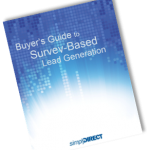 As year-end approaches, it’s time for B2B marketers to take stock of your lead gen efforts. Fortunately, early signs point towards a growing confidence among marketers that budgets will either remain the same or increase*. Regardless, whether you’re flush with cash or operating on a shoestring, the pressure to produce a strong ROI is constant. To help, here are 11 steps you can use to more efficiently generate the highest-quality, most cost-effective leads:
As year-end approaches, it’s time for B2B marketers to take stock of your lead gen efforts. Fortunately, early signs point towards a growing confidence among marketers that budgets will either remain the same or increase*. Regardless, whether you’re flush with cash or operating on a shoestring, the pressure to produce a strong ROI is constant. To help, here are 11 steps you can use to more efficiently generate the highest-quality, most cost-effective leads:
Create the right content for the right audience
1. Understand who your potential buyers are.
2. Define different segments – particularly if the profitability of your business differs from segment to segment.
3. Build personas – achieve agreement on who your buyer(s) are and gain alignment among sales and marketing teams.
4. Populate the buyer’s journey – determine what information prospects need and when.
5. Create great content – vital! When it comes to content, quality will always trump quantity – in fact, if your content isn’t relevant, unique, and insightful, it won’t matter how much you spend to promote it.
Budget & plan
6. Calculate the current average acquisition cost per customer segment. This is your total marketing spend per segment for your business year divided by the number of new customers you acquired in each segment.
7. Populate the following formulas:
- Number of sales x average revenue per customer = total revenue plan.
- Number of leads x conversion rates = number of sales needed.
Work back from revenue to determine your lead goal for each different segment.
8. Ensure that your lead generation budget is sufficient and realistic – it should allow for the number of customers sought, multiplied by the average acquisition costs from step 6.
9. Determine your most cost-efficient tactics – David T. Scott, in his book, “The New Rules of Lead Generation,” suggests the seven most successful lead-gen tactics are:
- Search engine marketing
- Social media advertising (LinkedIn, Twitter, etc.)
- Display advertising/banner ads
- Email marketing
- Direct mail marketing
- Cold calling
- Trade shows
Test, integrate, measure, & refine
10. Plan multiple A/B tests to determine which tactics work best for you. Create integrated campaigns to satisfy the myriad ways in which buyers now seek information, test each path and create measurable KPIs for each campaign. Taking an integrated approach helps generate the traffic necessary to drive your search rankings, creating a virtuous cycle.
11. Evaluate the KPIs and use data-driven insights to refine the process and improve your ROI. Ensure that marketing and sales goals and their corresponding KPIs are properly aligned to drive the right behaviors and processes. Misalignment will derail your efforts, rendering them at best, inefficient, and at worst, ineffective.
At the end of the day, most sales managers require simply two things from marketing: appointments with appropriate decision makers and collateral to substantiate their statements to help win deals. Today’s decision makers prefer to do the majority of their own research and aren’t interested in meeting with sales until they’ve judged vendors’ materials and offerings as being relevant and insightful. In fact, more than 50% of the content they consume comes from sources other than vendors’ websites, with the strongest influences being the recommendations and advocacy of colleagues and peers.
So how can marketing create great content that gets noticed and leads to engagement? One approach that works well is to survey your prospects first to identify hot button issues and concerns relating to your products and services. Armed with up-to-date knowledge you can craft relevant and helpful content as well as provide sales with unique insights to help with engagement and deal conversion.
As the buyer’s journey becomes increasingly more vendor-independent, lead generation strategies must evolve to continually meet buyers where they are. Establishing a lead-generation plan based on aligned understanding, goals, and corresponding metrics will provide marketers with the necessary information and insights to refine their efforts and improve their ROIs.
Learn more about how SimplyDIRECT’s demand-generation services might help you make sales appointments and deliver insightful lead intelligence. Click the image below to download the SimplyDIRECT Buyer’s Guide to Survey-based Lead Generation and find out more about leveraging surveys for content creation and lead generation.
What additional ideas do you have for creating compelling content?
Reference:
http://www.emarketer.com/Article/Nearly-Half-of-B2Bs-Expect-Marketing-Budget-Bump-2014/1010238

